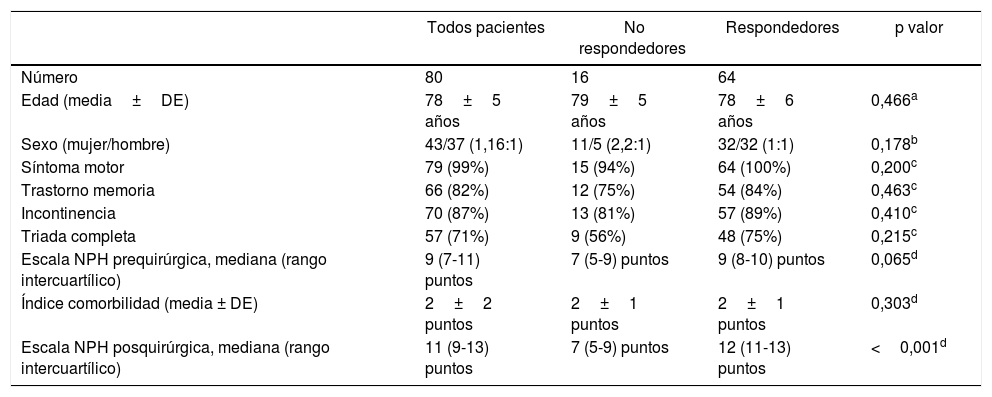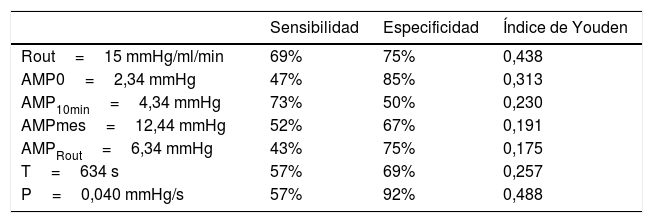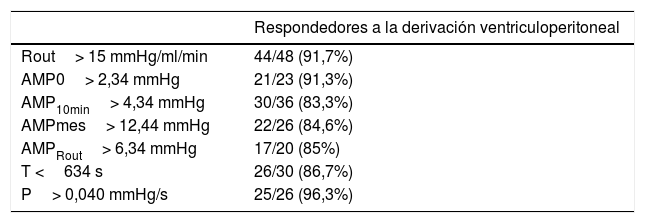Estudiar la validez pronóstica de la resistencia a la salida de líquido cefalorraquídeo (Rout) obtenida en el test de infusión lumbar en el estudio de la hidrocefalia idiopática de presión normal (iNPH), al igual que de las amplitudes en los diferentes tramos del test y otras nuevas variables obtenidas con el software Neuropicture®.
Materiales y métodosRevisamos retrospectivamente pacientes con «probable iNPH» a los que se les sometió a un test de infusión lumbar. Se determinó el valor predictivo positivo (VPP) del punto de corte con mayor precisión pronóstica de la Rout, la amplitud de pulso en reposo (AMP0), la amplitud en los primeros 10 min (AMP10min), la amplitud de meseta (AMPmes), la amplitud de Rout (AMPRout), el tiempo en alcanzar la meseta (T) y la pendiente de la curva hasta alcanzar la meseta (P). Se dividió a los pacientes en respondedores y no respondedores.
ResultadosEl estudio incluyó a 64 pacientes respondedores y 16, no respondedores. El VPP de Rout >15mmHg/ml/min fue 91,7%; de la AMP0> 2,34mmHg, 91,3%; de la AMP10min> 4,34 mmHG, 83,3%; de AMPmes> 12,44mmHg, 84,6%; de AMPRout> 6,34 mmHG, 85%; de T<634 s, 86,7%, y de P> 0,040mmHg/s, 96,3%.
ConclusionesLa Rout sigue siendo un criterio válido para indicar un shunt ventricular. Las amplitudes en diferentes tramos del test, junto a la T y la P son otras variables cuya positividad es indicativa de respuesta valvular y deberían formar parte del protocolo diagnóstico.
To study the prognostic value of the resistance to the cerebrospinal fluid outflow (Rout) obtained in the lumbar infusion test in idiopathic normal pressure hydrocephalus (iNPH), as well as the pulse pressure amplitudes in the different periods of the test and other new variables extracted by Neuropicture® software.
Material and methodsPatients with ́probable iNPH́ who underwent a lumbar infusion test were retrospectively revised. The positive predictive values (PPV) of the cutoff point of the best prognostic accuracy of the Rout, the basal pulse pressure amplitude (AMP0), the pulse pressure amplitude during the first 10minutes (AMP10min), the plateau pulse pressure amplitude (AMPmes), the Rout pulse pressure amplitude (AMPRout), the time to reach the plateau (T), and the slope until reaching the plateau were determined. Patients were categorized either as responders or non-responders.
ResultsThe study included 64 responders patients and 16 non-responders patients. The PPV of Rout> 15mmHg/ml/min was 91.7%; AMP0> 2.34mmHg: 91.3%; AMP10min>4.34mmHg: 83.3%; AMPmes>12.44mmHg: 84.6%; AMPRout>6.34mmHg: 85%; T <634seconds: 86.7%; P>0.040mmHg/sec: 96.3%.
ConclusionsRout is a valid criterion to indicate a ventricular shunt. Pulse pressure amplitudes in the different periods of the lumbar infusion test, in addition to T and P, are other variables whose positivity is indicative of shunt response and should be considered in the diagnostic protocol of the iNPH.
Artículo

Si es la primera vez que accede a la web puede obtener sus claves de acceso poniéndose en contacto con Elsevier España en suscripciones@elsevier.com o a través de su teléfono de Atención al Cliente 902 88 87 40 si llama desde territorio español o del +34 932 418 800 (de 9 a 18h., GMT + 1) si lo hace desde el extranjero.
Si ya tiene sus datos de acceso, clique aquí.
Si olvidó su clave de acceso puede recuperarla clicando aquí y seleccionando la opción "He olvidado mi contraseña".
















